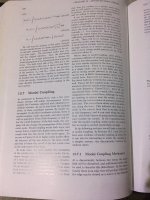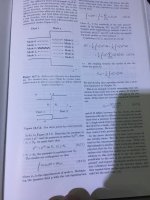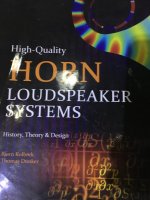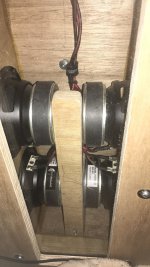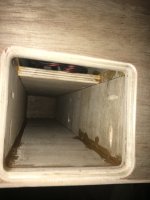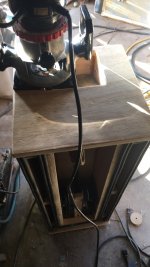Yup, what Swedish paper started it all for me too. thanks to you for sharing it. Sorry you don’t want any more answers to what they were looking for , or what they would have found if they wouldn’t have tapered it or stuffed it right away…We have been over this elsewhere, I trust in the math from people like David (hornresp), Martin Kings spreadsheets and so on. I know I will probably never ever learn the underlying math since I’ve seen it in Bjørn Kolbreks book and I don’t have to. It’s all physics and math, no hidden truths in the stars.
I simply liked to try a single folded tapered transmission line loaded at the end from a Swedish university paper and since the box includes a dsp/amp I wasn’t too worried about the outcome, it was later tuned to the room.
A friend needed a sub.. simple as that.
Martin King’s 0.349 Is the key. But that’s a door ajar already. Look inside
Last edited:
Keep going, There’s more to it that has been missedYup, what Swedish paper started it all for me too. Sorry you don’t want any more answers to what they were looking for , or what they would have found if they wouldn’t have tapered it or stuffed it right away…
Martin King’s 0.349 Is the key. But that’s a door ajar already. Look inside
Attachments
Bose have a interesting patent regarding loading a lot of drivers on different locations along the line of a resonant pipe. https://audioxpress.com/article/patent-review-bose-transmission-line-loudspeaker
Yes I know it’s a tapped horn but the underlaying principal is basically the same regarding putting a transducer in a resonant pipe whether it’s tapered, flared or “tapped”.
Yes I know it’s a tapped horn but the underlaying principal is basically the same regarding putting a transducer in a resonant pipe whether it’s tapered, flared or “tapped”.
It’s great that you eventually bought the book but I’ve have a hard time seeing what the theory about high frequency horns and modes/diffraction sources have to do with low frequency horns/transmission lines.Keep going, There’s more to it that has been missed
You should focus on chapter 28. Low-frequency horn speaker design. The part about method to reducing size is interesting.
I don’t know about the tapers. Or the curves. They don’t appear to be making things anything except diluted. And it shows up when you look at a higher orders of magnitude (as freqs ) already?Bose have a interesting patent regarding loading a lot of drivers on different locations along the line of a resonant pipe. https://audioxpress.com/article/patent-review-bose-transmission-line-loudspeaker
Yes I know it’s a tapped horn but the underlaying principal is basically the same regarding putting a transducer in a resonant pipe whether it’s tapered, flared or “tapped”.
Attachments
it simply doesn’t work you can’t have a cosine /sine wave in the same duct that tapers ands or flares. Unless it’s a bowtie shape or the opposite but you have to tame that as well from the start and distance from the beginning to drive or entry will screw that up . That doesn’t mean it doesn’t work as a speaker that means other things don’t work that might be beneficial to look at.
Superposition is game and low pass filter is a andsuperposition is game and low pass filter is a 180° turn with no other interruptions. It either makes it through or it doesn’t but if it doesn’t and it’s nearly the same wave as the approaching that does, its gain. Bottlenecking or air column mass in air particles. Reflections at the correct point and not at random folding your intervals and others doesn’t quite show it either. 180° turn sharp and to the point each time nothing else this is not as complicated as it has been made over the years I don’t think?
simple was right all along but simple was hiding in the numbers like pie is 80÷254.
It’s already spelled out If you look at the decimal points deep into and 1÷254 and what that means. The swing of a penguin is the length of byThe swing of a pendulum is the length of 1÷254… The meter is the definition of speed of light and the second as well. This is the timing sequence all that other stuff it’s just a blur if we look maybe we can understand something more
Superposition is game and low pass filter is a andsuperposition is game and low pass filter is a 180° turn with no other interruptions. It either makes it through or it doesn’t but if it doesn’t and it’s nearly the same wave as the approaching that does, its gain. Bottlenecking or air column mass in air particles. Reflections at the correct point and not at random folding your intervals and others doesn’t quite show it either. 180° turn sharp and to the point each time nothing else this is not as complicated as it has been made over the years I don’t think?
simple was right all along but simple was hiding in the numbers like pie is 80÷254.
It’s already spelled out If you look at the decimal points deep into and 1÷254 and what that means. The swing of a penguin is the length of byThe swing of a pendulum is the length of 1÷254… The meter is the definition of speed of light and the second as well. This is the timing sequence all that other stuff it’s just a blur if we look maybe we can understand something more
Just consider this. ODTL driver entry is the speed of light in radians (x2). That would be for 300 cm TL precisely. As shown in this story about a rectangle inside a pyramid shaped building
just look at the numbers the rest Doesn’t matter
- Home
- Loudspeakers
- Subwoofers
- Dual sub transmission line?!?
